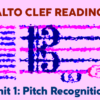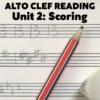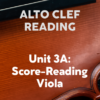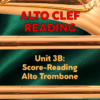Both the above texts deal with traditional form for the most part. The Green is a university text, but used copies are always turning up here or there, as it’s a heavily assigned book that results in a lot of resales. The Rosen book helps to put a lot of Green’s information into context. His book “The Classical Style” is also worth a read.
« Counterpoint by Walter Piston & A Treatise on Counterpoint in 40 Easy Lessons by Friedrich J. Lehmann (free from Project Gutenberg)
Harmony by Walter Piston Modulation by Max Reger Theory of Harmony by Arnold Schoenberg Twentieth-Century Harmony by Vincent Persechetti »
Related Posts
ALTO CLEF READING COURSE ORIENTATION
Welcome to the Orchestration Online Alto Clef Reading Course, designed to quickly and permanently im
ALTO CLEF READING, UNIT 1: PITCH RECOGNITION
FINDING A USEFUL SYSTEM When I was just about 14, I switched over from the violin to viola in my jun
ALTO CLEF READING, UNIT 2: SCORING
Note: make sure to read my first tip in this course on Alto Clef concerning Pitch Recognition, downl
ALTO CLEF READING UNIT 3A: VIOLA
If you’re new to reading the alto clef, but you’ve taken the time to drill yourself on Pitch Recogni
ALTO CLEF READING UNIT 3B: ALTO TROMBONE
If this is your first look at my Alto Clef Reading Course, jump back to the my first two sections on
ALTO CLEF READING UNIT 3C: CONTRALTO VOICE
This represents the final post in my series, “Alto Clef Reading Tips and Drills.” Make sure that you
ALTO CLEF READING, UNIT 4A: 100 SIGHT-SINGING DRILLS
100 ALTO CLEF SIGHT-SINGING DRILLS By this point in my Alto Clef Reading Course, you should have sha
Orchestration Tip: Horn Middle Register
For better control in delicate scoring, use the horn’s middle register, especially in the octave bet








